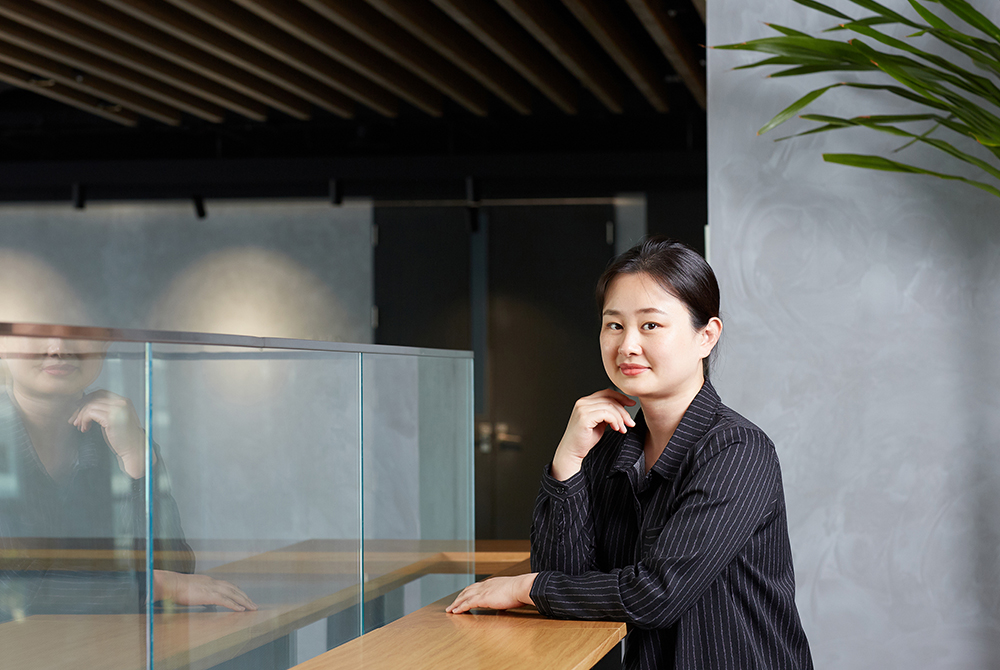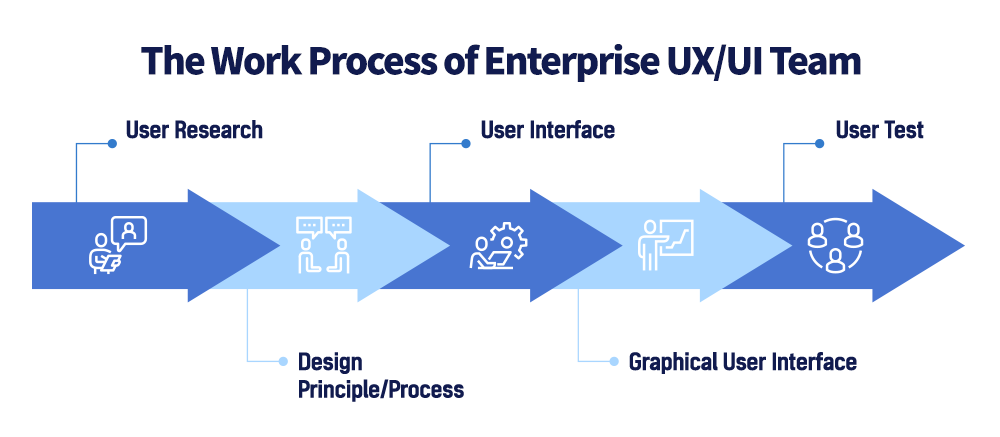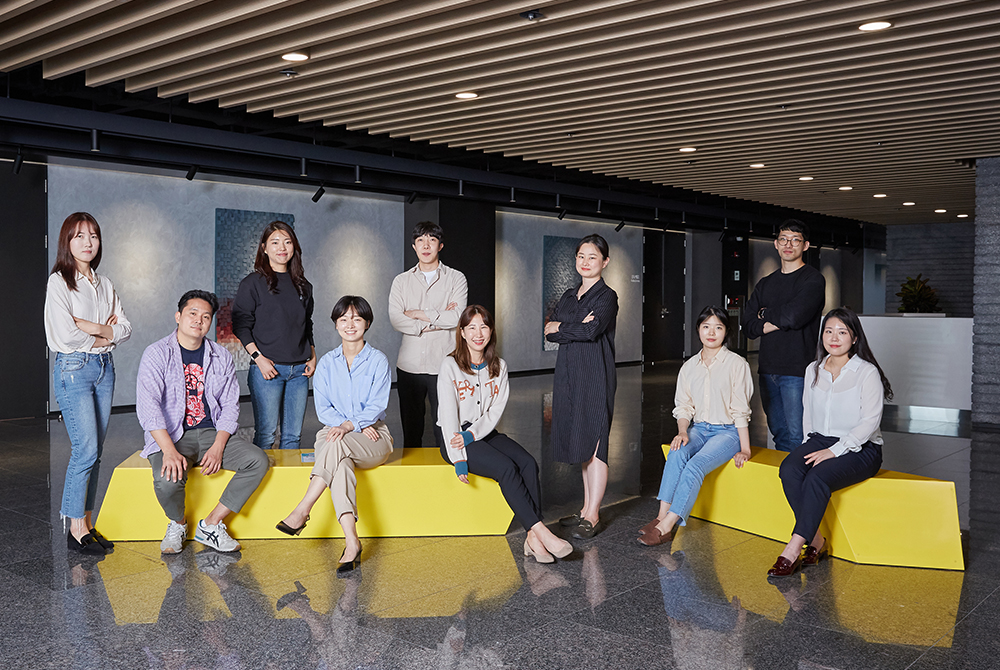
One of the main goals of the corporate “Digital Transformation (DT)” is creating an “agile” organizational culture that can quickly respond to the rapidly changing external environment. “Agile” here means a way of working that responds to uncertain business conditions and produces results quickly. Therefore, the core of DT is speed. Constitutional improvement of a company, however, is not realized merely by replacing technology and programs with new ones, like replacing nuts and bolts. To enable individual systems to work together in one organism, it is essential to speed up the work process, establishing a common norm and language system for employees.
This is also what Enterprise User Experience/User Interface (UX/UI) team is doing currently. Cutting-edge technologies such as artificial intelligence (AI), big data, and cloud are tools of DT, and Team connects these technologies and actual users by utilizing a methodology called “Design Thinking”, realizing real DT.
“Map Makers” Innovating the Work System
In 2016, SK hynix launched a DT organization to promote company-wide system innovation. It aims to allow what humans did manually, to be done by machine-learning algorithms and AI robots, so that human beings can perform higher-level work as administrators. This is the vision of DT organization, which aims to become an “Intelligent Enterprise” that proactively proposes new values to customers, beyond the concept of a simple manufacturing company.
Enterprise UX/UI Team was formed with nine UX/UI designers earlier this year, led by Project Leader (PL) Hanna Kim. The team is working to make a path towards this vision. Kim has various hands-on experiences ranging from hardware (H/W) to software (S/W) and from B2C to B2B service. All members of the team are experts with at least three years of experience in service planning and design in the IT industry.
Before this team was formed, SK hynix had encountered two major challenges in realizing DT. The first was an inefficient work environment due to long-accumulated sprawling development. Since work programs were developed randomly whenever needed in the field without consistent standards, the functions of the programs were overlapping and each department was using different programs, decreasing the efficiency in collaboration.
The second challenge was inconvenient usability, which was common to programs developed while ago. Due to the high complexity of the interface and additional functions, essential functions couldn’t be properly used and multiple systems had to be operated for just a single task. These problems were also obstacles for newly joined employees to learn the work process. In the early stages of building a system, employees had to adjust themselves to the system, as the implementation of functions was the immediate priority. In the case of DT, however, adjusting systems to human beings is its main priority.
Enterprise UX/UI Team integrates and reorganizes numerous in-house systems that are indiscriminately used, and improves the complex functionality and usability of individual service to make it reasonable from a user’s point of view. Sometimes, the team boldly gets rid of unnecessary systems or newly designs systems.

Hanna Kim who leads Enterprise UX/UI team likened the Team’s role to “making a map”. The team reconnects or repairs the old and complex paths of tasks causing traffic jams, and sometimes boldly removes paths or adds new paths when needed to create a road map which allows a smooth workflow.
“At SK hynix, nearly 30 thousand people make semiconductor products through hundreds of systems. However, nobody really knew how these numerous programs were running, in what system, as a whole. Although there are many work tools quantitatively, they do not work organically, hindering flexible response to rapidly changing environments. We are working to reorganize these fragmented systems to make them work reasonably from the employee’s point of view. We are also building a work environment with equal accessibility for all organizations and departments. You can see that we are redrawing a map of internal systems that are fragmented and illegible.”
A Big Picture Drawn through “Design Thinking”

As the name suggests, Enterprise UX/UI collectively refers to all tasks that rationally change the user experience, namely employees’ work activities by redesigning all elements of a user interface within corporate services. As the outcome of UX/UI design is implemented in “graphic design”, it is officially called UX/UI “design”. In fact, however, the concept of it is closer to the meaning of “construction”, rather than “visualization” that we commonly think of. These designers’ jobs may seem just as simple as changing a button on a web page at a glance, but this job encompasses changes in the entire system. It is a “converged” job that simultaneously performs the work of a planner and a designer.

The work process is largely summarized into four stages: problem collection > problem definition > solution derivation > field application (test).
UR/UT Part plays the role of “goalkeeper” responsible for the beginning and end of the project. When a complaint related to a specific work system is received from the field, UR/UT Part analyzes the user behavior patterns to define problems to be solved. This process is called as user research (UR). When the project mission is decided from UR, this is thoroughly analyzed again from the user’s point of view to decide the direction for improvement (UX concept) based on the design principles. This role is performed by UX Planning Part.
When the standard is determined, User Interface (UI) Part specifically designs the new construction of the screen that is seen to users. When Graphical User Interface (GUI) Part completes the solution by adding design elements such as colors and icons on the blueprint, based on the characteristics of the service, UR/UT Part takes it back to the field to conduct a user test to confirm the inconvenience of the client (employee) is resolved. If an unresolved problem is found, a complementary measure is sought for, by going back to the first stage.
This problem-solving method that is thoroughly approached from the user’s point of view is called “Design Thinking”. By repeating the process from UR to UT, and to a new UR, Design Thinking narrows the distance between service and users, as if weaving a net. As more services are improved in this way, the overall workflow of the company becomes smoother, and the job satisfaction of the employees increases. Ultimately, enhancing the speed and efficiency of work is their core task.
The above process is called the Design Project Process where the common design principle must be observed to realize a consistent user experience between different services. The UX/UI standard is optimized for employees’ work environment to present a common vision and level up the user experience. It was named “Signal Design System” in line with the purpose of the implementation of “conveying meaning through visual language to meet the service purpose.”
The World of Designers who Make the “Map of Work”
Unlike designing tangible products, UX/UI is not popularly known in that it designs intangible services. For this reason, the importance of the tasks of the team does not usually stand out externally as it actually is. Enterprise UX/UI Team members are working for others harder than anyone, outside the spotlight.
Members of Enterprise UX/UI Team said they find it most difficult to make clients, who are employees using the existing system, understand the necessity of the service improvement. Especially, employees who have been in the field since the program was first created often do not feel the need for improvement. It is not easy to reach a consensus on the need for changes, as employees are already familiar with using inconvenient and complicated interfaces by memorizing certain patterns. In addition, it is difficult to understand the entire development process since many programs were developed long ago.

Enterprise UX/UI Team is preparing a separate collaboration process to fundamentally solve this problem. Kim said, “We are currently working to build a collaborative process where major related departments can review together in terms of service quality improvement and cost efficiency.” She added, “The main goal of this is to establish a systematic communication channel to create a consensus on the reason why a problem should be resolved and what information we need exactly in this process.”
All members of the team said that there exist great experience and fascinating points that can be obtained only by this job.

When asked about their moments of achievement, Technical Leader (TL) JiHee Cho, responsible for Design Principle/Process Part said, “I feel rewarded when I draw solutions through Design Thinking process for problems that are difficult for a developer to solve alone, and when I hear positive responses from employees in the field about the reasonable and practical solutions derived from this new approach.” TL Jiyeon Lee in charge of UI Part said, “It is sometimes hard because of complicated and difficult domain knowledge due to the nature of the manufacturing sector, but the sense of accomplishment we feel when overcoming difficulties and solving problems is the fascinating point that only UX/UI job has.”
In particular, as an advantage of working as a UX/UI designer at SK hynix, all members mentioned “consistent work direction”. Unlike B2C companies where designers often have to mediate contrasting interests between the company and consumers, employees at SK hynix are the clients and end consumers at the same time. For this reason, members can focus solely on user experience. Kim emphasized that “this allows designers to concentrate all their time and ability on users and to plan and design high-quality services, which is also beneficial for the growth of each designer.”

Due to the nature of UX/UI work that requires a converged way of thinking, it is important to make efforts to improve the overall work capability through various self-developments, as well as ability to utilize the design tools. This is because knowledge on humanities such as philosophy, cognitive psychology, ergonomics, and behavioral economics is essential for understanding the patterns of user behaviors.
TL Ryunghwa Rhee responsible for GUI Part said regarding this, “I think the most important element as UX/UI designers is ‘empathic ability’. Officially named a ‘designer’, but in fact, the actual work is more like a consultant. UX/UI is an attractive job that anyone who enjoys looking at and analyzing problems from the perspective of others, even if you didn’t major in design.”
TL Namkyu Kang in charge of UR/UT Part said, “Adding all functions that you think necessary is not good for developing a program. A great UX/UI design requires a service value-based analysis ability that can distinguish between functions from a user’s point of view, rather than approaching the problem with design engineering thinking or individual designer’s preference.”

Enterprise UX/UI Team opened the first shovel for DT innovation of SK hynix, working through various difficulties together. Their ultimate goal is to make a virtuous cycle of ecosystem in which improved systems increase work efficiency and productivity, which leads to more employees’ performance, rewards and new value creation.




